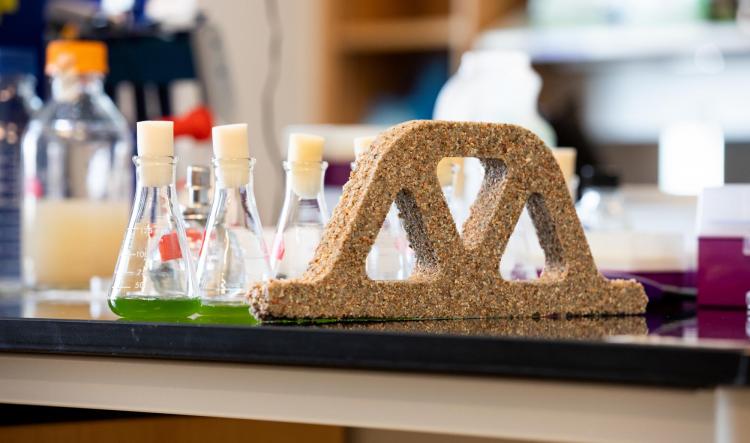University of Colorado Boulder researchers are using living bacteria to create bricks that can self-heal and are strong enough to be used in building construction.
January 30, 2020

|
CU Boulder researchers have developed a bacteria-based material that consumes carbon dioxide and grows into bricks with a strength comparable to traditional construction materials. (Image source: CU Boulder College of Engineering and Applied Science) |
Scientists at University of Colorado (CU) Boulder have a developed a means of using bacteria to create building materials, a discovery that could help reduce the construction industry's carbon footprint.
The researchers have created new material based on living bacteria that consumes carbon dioxide to grow into bricks. These bricks are durable and strong enough to be used as a building material, as well as include a number of benefits over the cement and mortar used widely today, according to CU Boulder.
The team published a paper on their work in the journal Matter.
“We already use biological materials in our buildings, like wood, but those materials are no longer alive,” Wil Srubar, an assistant professor in CU Boulder’s Department of Civil, Environmental and Architectural Engineering, said in a press statement. “We’re asking: Why can’t we keep them alive and have that biology do something beneficial, too?”
To explore this idea, researchers began experimenting with cyanobacteria that’s part of the genus Synechococcus. What they found is that under certain conditions, these microbes grow by absorbing carbon dioxide gas and then make calcium carbonate, which happens to be the main ingredient in limestone as well as cement.
To fabricate a building material from the bacteria, Srubar and his team inoculated colonies of cyanobacteria into a solution of sand and gelatin, and then set about tweaking the material for their desired result.
Living Bricks
In the end, the calcium carbonate churned out by the microbes mineralized the gelatin and bound the sand together into a brick, forming not only a new construction material that also removes carbon dioxide from the air.
The resulting bricks have a strength on par with the mortar used by construction contractors today even when subjected to a range of humidity conditions, Srubar said. “You can step on it, and it won’t break,” he said in a press statement.
But the researchers found having a new material for building was just the tip of the iceberg. Once they created a brick from the bacteria, they also discovered that they could make their materials reproduce – growing back to full size if a brick is chopped in half. This paves the way for materials than can self-heal cracks other damage.
“We know that bacteria grow at an exponential rate,” Srubar explained. “That’s different than how we, say, 3D print a block or cast a brick. If we can grow our materials biologically, then we can manufacture at an exponential scale.”
The CU Boulder researchers still need considerable time to find a way to create a commercial version of the bacteria-based material, which needs humidity to survive, among other challenges.
However, they foresee a future use for the material as a way to greatly simplify the construction process. Someday, adding water to a bag full of ingredients could be all people need to build their own homes in an environmentally-friendly way.
“Nature has figured out how to do a lot of things in a clever and efficient way,” Srubar said “We just need to pay more attention.”
RELATED ARTICLES:
Elizabeth Montalbano is a freelance writer who has written about technology and culture for more than 20 years. She has lived and worked as a professional journalist in Phoenix, San Francisco and New York City. In her free time she enjoys surfing, traveling, music, yoga and cooking. She currently resides in a village on the southwest coast of Portugal.
About the Author(s)
You May Also Like




